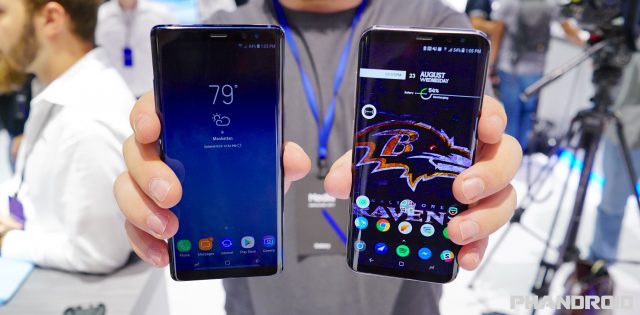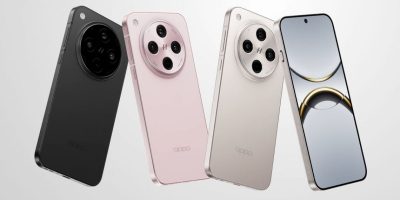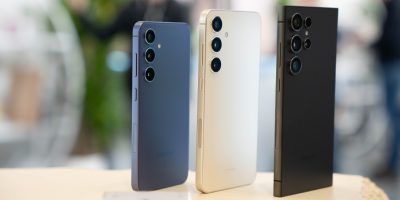Samsung typically challenges the top charts of major smartphone components in terms of quality in almost all areas. They regularly find themselves near the top of DxOMark’s camera list, though HTC has had a lot to say about that in recent years.
But one area that others still can’t seem to match Samsung in is the display, with the company typically pushing the bar year after year and forcing DisplayMate to award Samsung with the best marks for each new flagship launch. That trend continued with the Galaxy S8, and now the Galaxy Note 8 will take it to even newer heights: it’s the first ever smartphone to be awarded an A+ by the display experts.
DisplayMate’s list of positives is as long as you’d expect:
- A radical new Full Display Screen design that fills almost the entire front face of the phone providing a significantly larger display for the same phone size.
- A curved screen OLED display that is manufactured on a flexible plastic substrate so that it can bend around corners on both sides of the phone to provide two curved Edge Display areas that can be viewed and controlled from both the front or the sides.
- A new larger6.3 inch Full Screen Display that fills almost the entire front face of the Galaxy Note8 from edge-to-edge. Its display is 20% larger in screen area than the Galaxy S8 and 14% larger than previous Galaxy Note displays, without increasing the size of the phone, which is accomplished by shrinking the borders around the display. The Home button and Navigations buttons are now incorporated within the touchscreen display.
- A new display form factor with a taller height to width Aspect Ratio of 18.5 : 9 = 2.05, which is 15% larger than the 16 : 9 = 1.78 on most Smartphones (and widescreen TVs) because the display now has the same overall shape as the entire phone. It is taller in Portrait mode and wider in Landscape mode. This provides extra space for Notifications and for displaying multiple Apps and content simultaneously on-screen side-by-side.
- 4 Color Gamuts and 3 Calibrated Screen Modes with High Absolute Color Accuracy based on our extensive Lab Measurements.
- A new larger full 100% DCI-P3 Color Gamut and Digital Cinema mode that is also used for 4K Ultra HD TVs, so the Galaxy Note8 can display the latest high-end 4K video content. The DCI-P3 Gamut is 26 percent larger than the Rec.709 Gamut that is used in 2K Full HD TVs.
- The Galaxy Note8 is certified by the UHD Alliance for Mobile HDR Premium, which allows the Galaxy Note8 to play the same 4K High Dynamic Range content produced for 4K UHD Premium TVs.
- A larger Native Color Gamut with a new high saturation “Deep Red” OLED, resulting in a very impressive 112% of DCI-P3 and 141% of sRGB / Rec.709 Gamuts that also provides much better on-screen Colors in High Ambient Light.
- A3K Higher Resolution 2960 x 1440 Quad HD+ display with 521 pixels per inch, and Diamond Pixels with Sub-Pixel Rendering.
- AVideo Enhancer that provides HDR-like Expanded Dynamic Range for all videos that don’t have HDR coding.
- A record high Peak Display Brightness of over 1,200 nits, which improves screen visibility in very high Ambient Light, and provides the high screen Brightness needed for HDR.
- Front and back Dual Ambient Light Sensors for significantly improved Automatic Brightness settings.
- ANight Mode with a Blue Light Filter that allows the user to adjust and reduce the amount of blue light from the display for better night viewing and improved sleep.
- Aser Adjustable White Point with Color Balance slider controls that can change the color of White for the Adaptive Display screen mode.
- An Always On Display mode and Personalized Auto Brightness Control.
- SmallColor Shifts and Brightness Shifts with Viewing Angle.
- TheGalaxy Note8 can be used with Polarized Sunglasses in both the Portrait and Landscape orientations unlike LCDs, which generally work in only one of the two orientations.
- A new and even stronger curved Gorilla Glass 5 protecting the display.
And also seems to set a mouthful of new records:
- Largest Native Color Gamut (112% DCI-P3 and 141% sRGB / Rec.709).
- Highest Peak Display Brightness (1,240 nits).
- Highest Contrast Rating in Ambient Light (270).
- Highest Screen Resolution 3K (2960×1440).
- Highest Contrast Ratio (Infinite).
- Lowest Screen Reflectance (4.6 percent).
- Smallest Brightness Variation with Viewing Angle (29 percent).
We can’t say we’re surprised. There’s little on the market challenging Samsung’s smartphone OLED panels right now. Competition is coming for sure, but for now they’re in a league of their own. Hit up DisplayMate for the full breakdown.












Comments